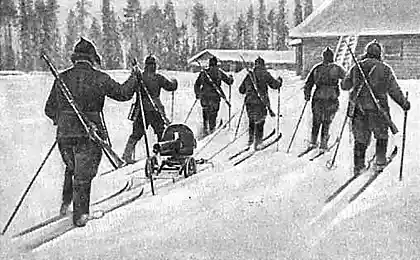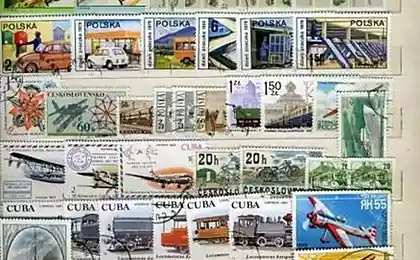661
They were the first (9 photos)
Maybe this post would have been appropriate to close by April 12, but ...
Feb. 3, Iran announced the successful launch of its first rocket into space - "Kavoshgar 3". On board - a mouse, two turtles and a few worms. Iran's first "astronauts" returned to Earth safely, although the news has become for Western agencies are not the most pleasant: in fact they are now even more agitated that space technology can help Tehran develop nuclear warheads. And we, in the meantime, let us remember the brave our little brothers, who first visited in space.
1. The first was our Laika. In 1957, the Soviet Union launched into Earth orbit dog. Laika, which was formerly homeless, was chosen from three candidates. Even though she died a few hours after the launch, it proved that a living being could survive the launch and weightlessness. (Corbis / Bettmann)

2. Dog handlers at the Academy of Sciences show their best dogs to participate in the space program. In the 1950s and 1960s the Soviet Union launched a mission in which there were 57 slots for dogs. As a result, flew into space much smaller animals, but some dogs have been there more than once.

3. Squirrel monkey, wrapped in rubber rubber, tied and placed in the capsule during a training exercise for a flight into space. Her companion, known as Gordo, in the same way to go into space in 1958 to a height of 498 km. Although it is believed that Gordo survived his parachute did not work, and the capsule was lost at sea.

4. The first two monkeys survived a journey into space, presented at a press conference by NASA in 1959. Abel (left) - 3-pound rhesus monkey, and Baker - 311-gram squirrel monkey from Peru, experienced hand at 38 times the normal force of gravity and weightlessness for 9 minutes during his historic flight. Able died four days after returning to Earth at the time of surgery to remove the electrode. Baker lived until 1984.

5. At the beginning of 1961 - a few months after Gagarin's flight into space - NASA used chimpanzees, to help troubleshoot problems in the program "Mercury". About 20 chimpanzees were trained at the airport "Holloman" in New Mexico on a special simulator.
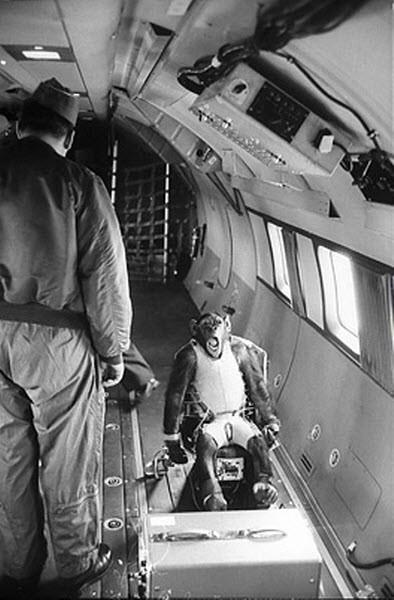
6. Chimpanzees on the basis of "Holloman" taught to perform simple tasks in response to the electric light and sounds. Jim - chimpanzee pictured - was wrong: here he had to press the middle lever.

7. Chimpanzee participating in the program, are preparing to launch a capsule "Mercury".
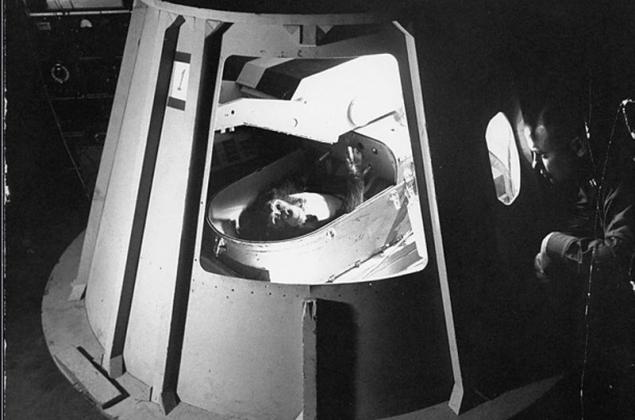
8. The two chimpanzees were successfully launched into orbit. The chimpanzee named Ham, whose journey lasted 16 minutes and 59 seconds, held in January 1961. His brother Enos launched ten months later. Enos walked around the Earth twice.

9. After his brief trip into orbit Ham landed in the Atlantic Ocean, and it, along with a capsule lifted rescue boat. During the flight, he was only slightly injured nose.
via rikosha
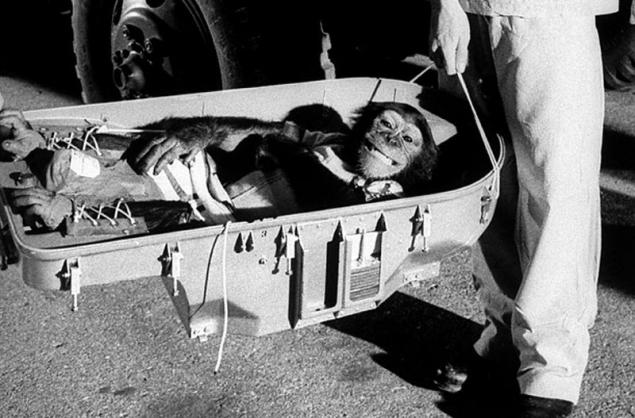
Source:
Feb. 3, Iran announced the successful launch of its first rocket into space - "Kavoshgar 3". On board - a mouse, two turtles and a few worms. Iran's first "astronauts" returned to Earth safely, although the news has become for Western agencies are not the most pleasant: in fact they are now even more agitated that space technology can help Tehran develop nuclear warheads. And we, in the meantime, let us remember the brave our little brothers, who first visited in space.
1. The first was our Laika. In 1957, the Soviet Union launched into Earth orbit dog. Laika, which was formerly homeless, was chosen from three candidates. Even though she died a few hours after the launch, it proved that a living being could survive the launch and weightlessness. (Corbis / Bettmann)

2. Dog handlers at the Academy of Sciences show their best dogs to participate in the space program. In the 1950s and 1960s the Soviet Union launched a mission in which there were 57 slots for dogs. As a result, flew into space much smaller animals, but some dogs have been there more than once.

3. Squirrel monkey, wrapped in rubber rubber, tied and placed in the capsule during a training exercise for a flight into space. Her companion, known as Gordo, in the same way to go into space in 1958 to a height of 498 km. Although it is believed that Gordo survived his parachute did not work, and the capsule was lost at sea.

4. The first two monkeys survived a journey into space, presented at a press conference by NASA in 1959. Abel (left) - 3-pound rhesus monkey, and Baker - 311-gram squirrel monkey from Peru, experienced hand at 38 times the normal force of gravity and weightlessness for 9 minutes during his historic flight. Able died four days after returning to Earth at the time of surgery to remove the electrode. Baker lived until 1984.

5. At the beginning of 1961 - a few months after Gagarin's flight into space - NASA used chimpanzees, to help troubleshoot problems in the program "Mercury". About 20 chimpanzees were trained at the airport "Holloman" in New Mexico on a special simulator.

6. Chimpanzees on the basis of "Holloman" taught to perform simple tasks in response to the electric light and sounds. Jim - chimpanzee pictured - was wrong: here he had to press the middle lever.

7. Chimpanzee participating in the program, are preparing to launch a capsule "Mercury".

8. The two chimpanzees were successfully launched into orbit. The chimpanzee named Ham, whose journey lasted 16 minutes and 59 seconds, held in January 1961. His brother Enos launched ten months later. Enos walked around the Earth twice.

9. After his brief trip into orbit Ham landed in the Atlantic Ocean, and it, along with a capsule lifted rescue boat. During the flight, he was only slightly injured nose.
via rikosha

Source:






